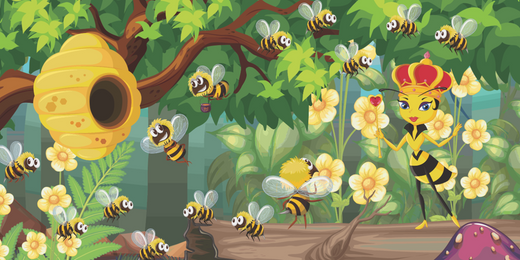
A Queen Bee's Role | The Heart of the Hive
In the intricate world of bees, the queen bee stands as the linchpin of the hive, ensuring its survival and prosperity. Her role goes far beyond what her title suggests, encompassing complex biological functions, social hierarchies, and even the overall health of the colony. Understanding the queen bee's role is crucial for any beekeeper, as her health and behavior directly influence the hive's productivity and well-being.
The Life of a Queen Bee
The journey of a queen bee begins much like any other bee—in an egg. However, her path diverges early on due to the royal treatment she receives from the worker bees. Unlike regular worker larvae, which are fed a mixture of pollen and nectar, a future queen is fed exclusively on royal jelly. This nutrient-rich substance triggers the development of her reproductive organs, setting her apart from the sterile worker bees.
Once she emerges from her queen cell, the new queen bee’s first task is often to seek out and eliminate any rival queens within the hive. This ensures that she becomes the sole reigning monarch. After this initial period of consolidation, she embarks on a mating flight, during which she will mate with several drones (male bees) from other colonies. This mating occurs high in the air, ensuring genetic diversity. The sperm collected during this flight is stored in a specialized organ called the spermatheca, allowing the queen to fertilize eggs throughout her life, which can last up to five years.
The Queen's Role in Egg Laying
The queen bee's primary function is to lay eggs. In a healthy hive, she can lay up to 2,000 eggs per day during the peak season, ensuring a steady supply of new workers to maintain the colony. The eggs she lays can develop into worker bees, drones, or new queens, depending on how they are cared for by the workers.
The queen bee has the unique ability to control the sex of her offspring. Fertilized eggs develop into female workers or queens, while unfertilized eggs become male drones. This ability to choose whether to fertilize an egg allows the queen to maintain the necessary balance of workers and drones in the hive. Worker bees, which are all female, perform various tasks within the hive, including foraging for food, caring for the young, and protecting the hive. Drones, on the other hand, have a singular purpose: to mate with a virgin queen from another hive.
The Queen's Influence on the Hive
Beyond her role in reproduction, the queen bee exerts a powerful influence over the hive through the release of pheromones. These chemical signals play a crucial role in maintaining the social structure of the colony. The queen's pheromones are distributed throughout the hive by the worker bees, signaling her presence and suppressing the development of ovaries in the worker bees. This ensures that she remains the sole reproductive individual in the hive, preventing chaos and competition.
The queen's pheromones also have a calming effect on the hive. A healthy queen emits strong pheromones, which keep the worker bees content and focused on their tasks. If the queen's pheromone levels drop—whether due to age, illness, or injury—the hive may become restless. This can lead to behaviors such as swarming, where a portion of the colony leaves to form a new hive, or the workers may begin raising a new queen to replace the failing one.
The Importance of Queen Health and Management
For beekeepers, managing the health and productivity of the queen bee is paramount. A strong, healthy queen ensures a thriving hive, while a weak or failing queen can spell disaster for the colony. Regular hive inspections should include a check on the queen's egg-laying pattern. Consistent, densely packed brood cells are a sign of a healthy queen, whereas spotty or irregular patterns may indicate problems.
If a queen bee is not performing well, beekeepers may need to replace her to maintain the hive's productivity. This process, known as requeening, involves introducing a new queen to the hive. The introduction must be done carefully, as the worker bees may initially reject a new queen. Typically, the new queen is placed in a small cage within the hive, allowing the bees to become accustomed to her pheromones before she is released.
The Queen Bee's Central Role
The queen bee is truly the heart of the hive, responsible for its growth, stability, and overall health. Her unique ability to lay eggs and produce pheromones that regulate the colony's behavior underscores her importance. For beekeepers, understanding and managing the queen bee is key to successful beekeeping, ensuring that the hive remains productive and harmonious. In the intricate dance of hive life, the queen bee leads, not through force, but through her indispensable role in the delicate balance of the bee community.



Leave a comment